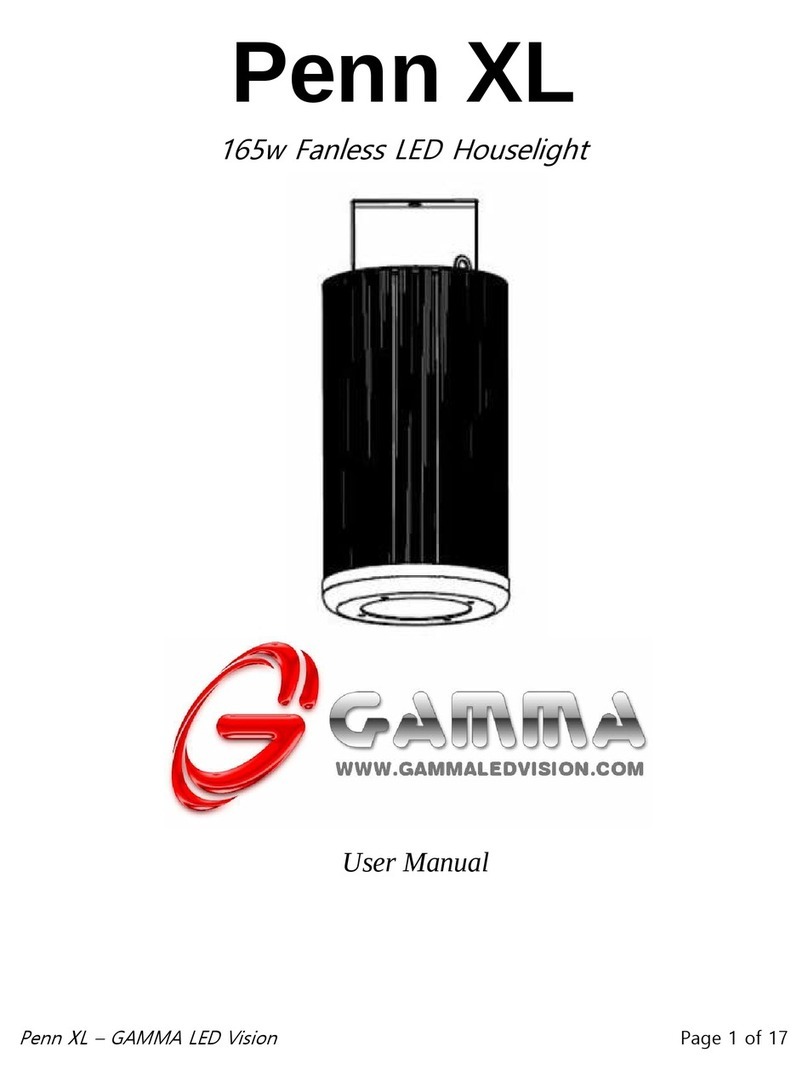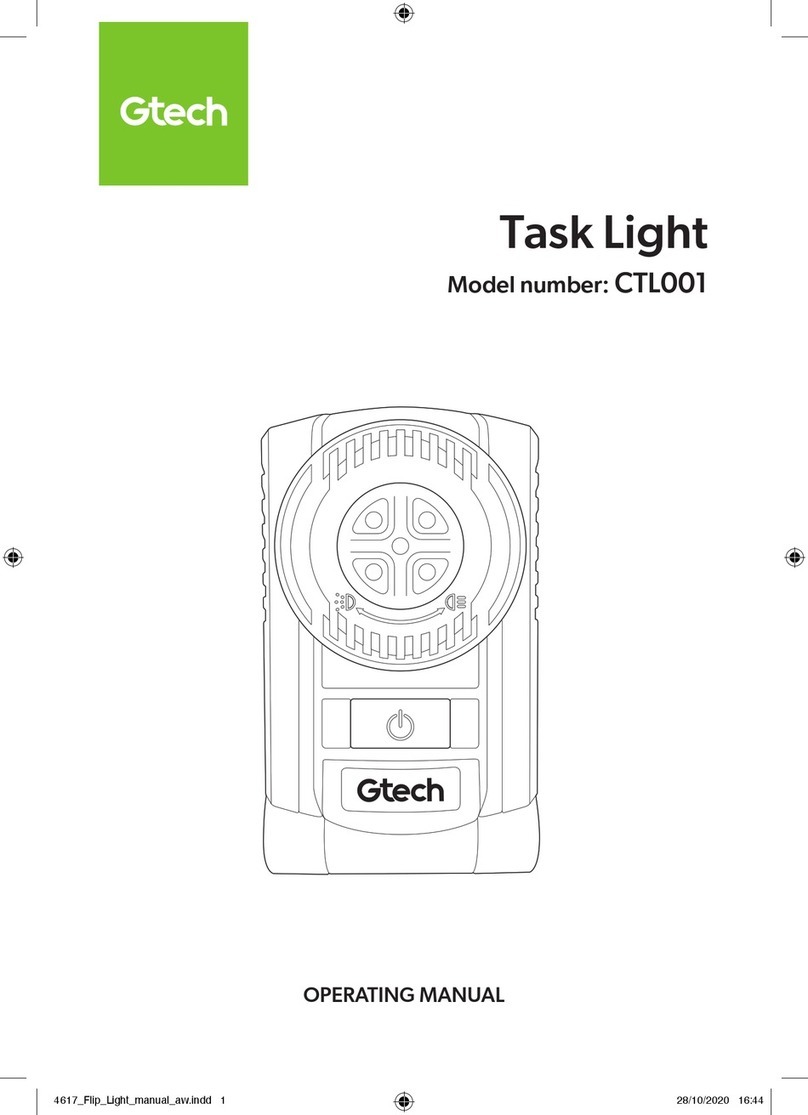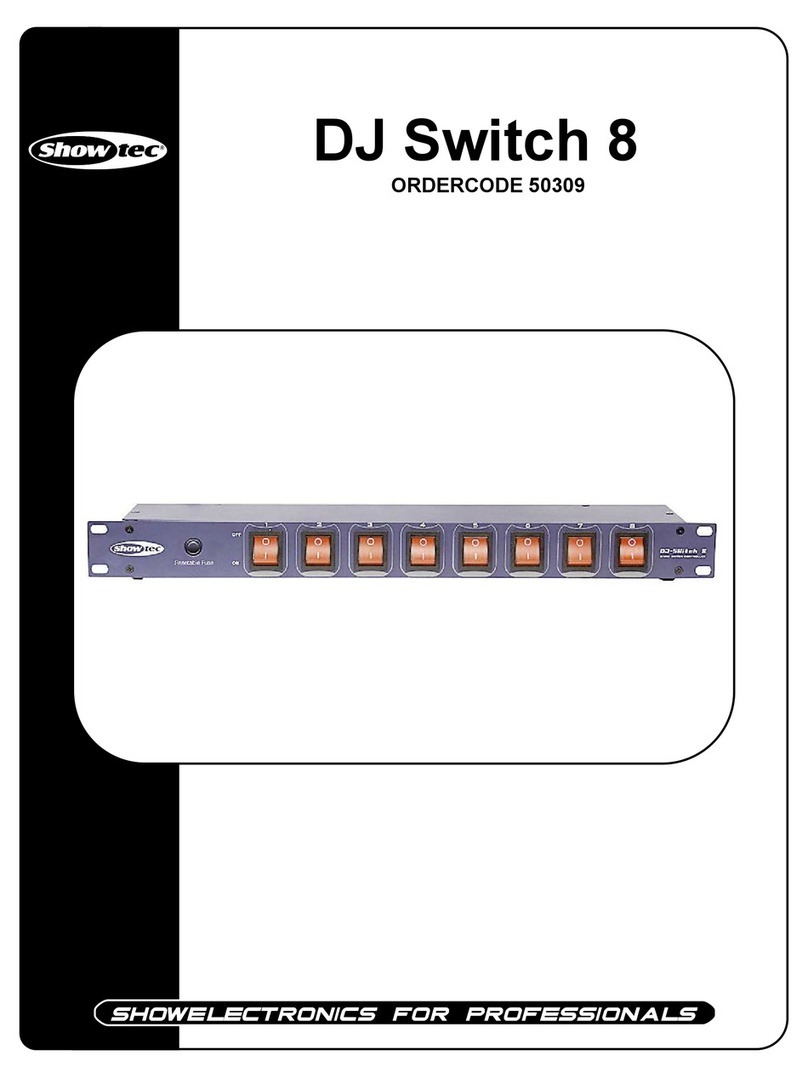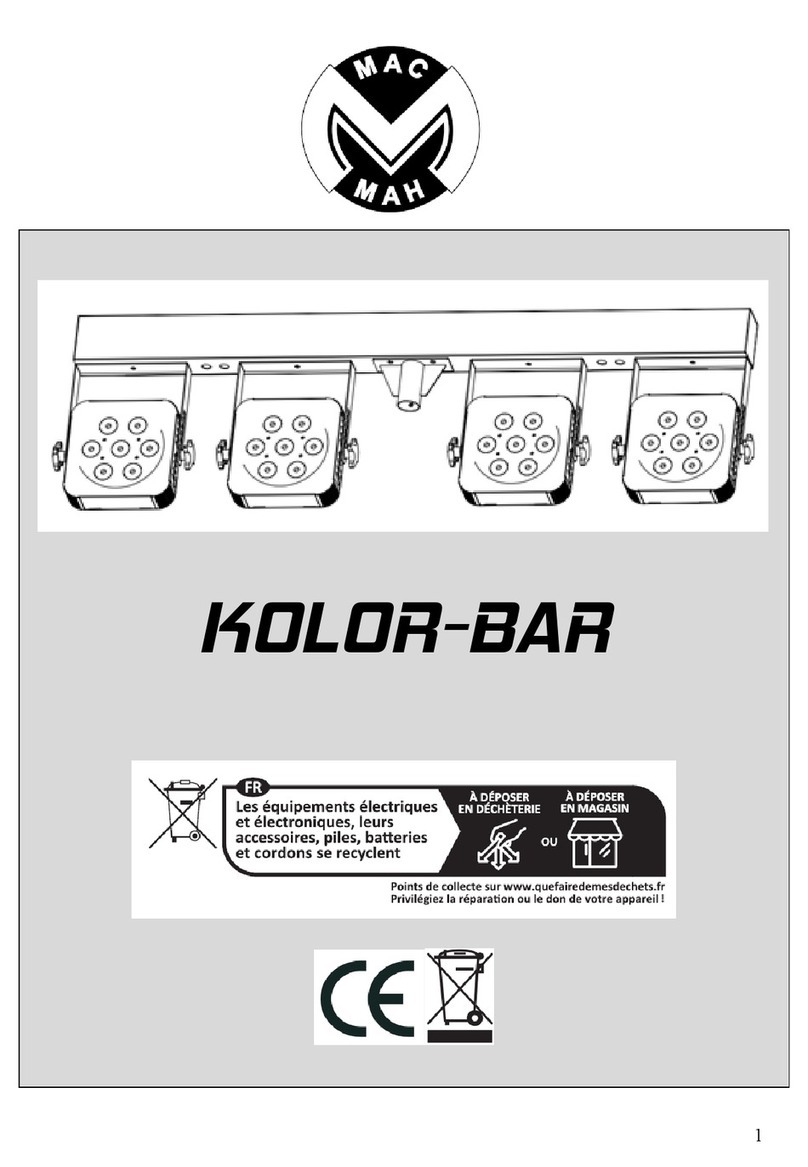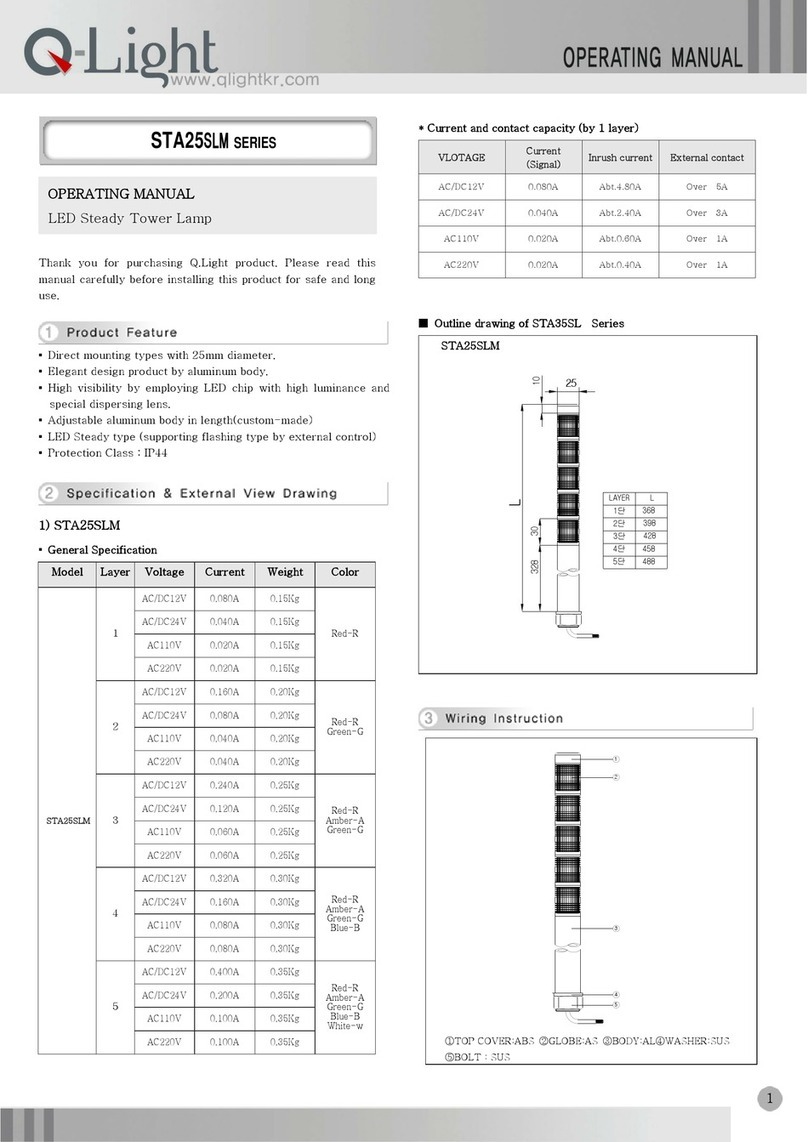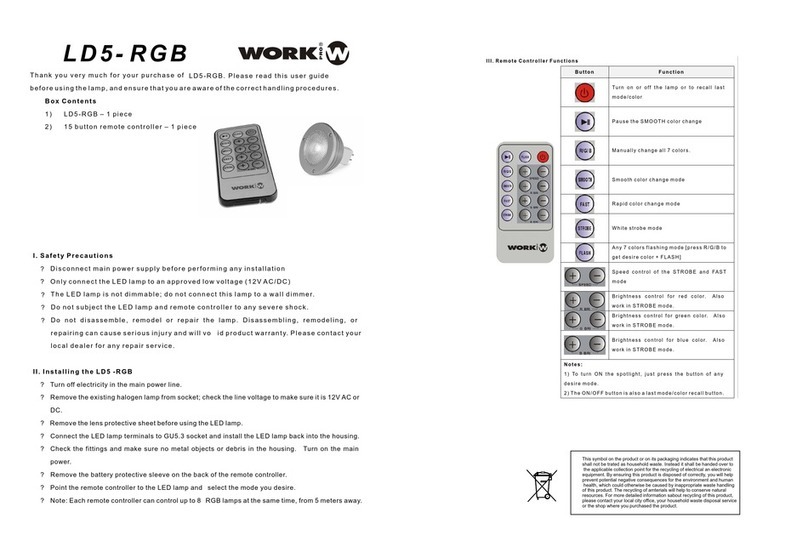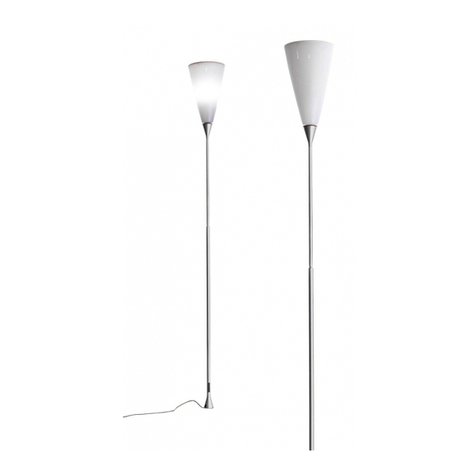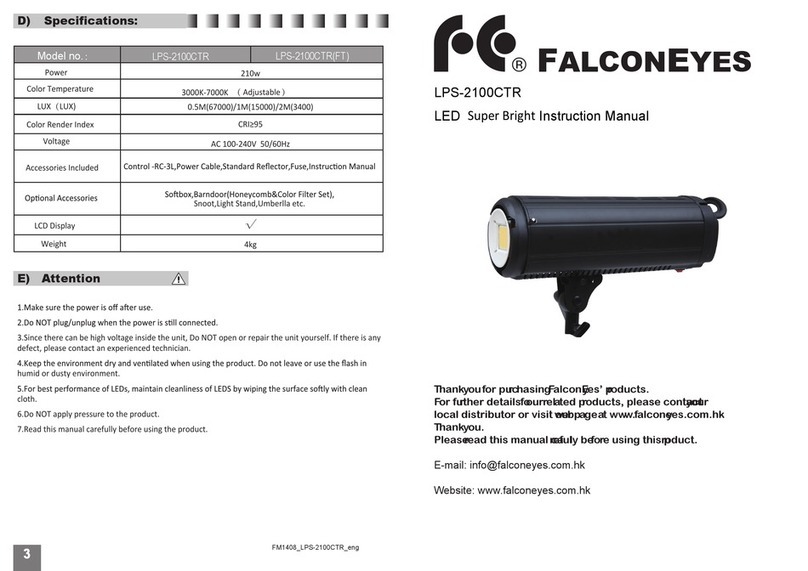elektraLite eyeBall Quad led User manual

Elektralite eyeBall Quad led
USER MANUAL
Elektralite (a division of Group One),
70, Sea Lane, Farmingdale, NY11735, U.S.A.
T. +1 (516)-249-3662. F. +1 (516)-249-8870
WWW.MYELEKTRALITE.COM

1. Unpacking
Thank you for choosing the Elektralite eyeBall fixture. For your own safety, please read this manual
before installing the device. This manual covers important information on installation and applications.
Please keep this manual for future reference.
Elektralite eyeBall wash fixture uses 7 high powered 10 watt quad leds in a balanced arrangement
giving incredible output. Please unpack the Elektralite eyeBall carefully and check whether it was
damaged in shipping.
The following item should be in the box with the fixture:-
2 part yoke
2 knobs for yoke
1 DMX 5 pin cable
1 Turnaround 3 to 5 pin cable
1 Turnaround 5 to 3 pin cable
1 IEC power cable
1 IEC jumper cable (for joining fixtures)
2. Safety Instructions.
This device has left the factory in perfect condition. In order to maintain this condition and to ensure a
safe operation, it is absolutely necessary for the user to follow the safety instructions and warning
notes written in this user manual. Elektralite eyeBall is a high voltage fixture. Be careful when dealing
with high voltages.
Please read this manual. If you do not read this manual and damages occur to the Elektralite
eyeBall, then it could void the warranty.
During shipping, the Elektralite eyeBall may have been exposed to high temperature changes or
humidity changes. So, as a precaution, do not switch the Elektralite eyeBall on immediately.
Condensation can damage the Elektralite eyeBall so leave the Elektralite eyeBall switched off until it
has reached room temperature. The Elektralite eyeBall is an INDOOR operational fixture. Do not
operate this fixture outdoors or anywhere there is high humidity.
The electrical connection must carry out by a qualified person and it is absolutely essential that the
Elektralite eyeBall be grounded. So under no circumstances break off the ground pin on the Edison
plug or use the fixture where a ground is not present. A ground pin, like the fuse for the Elektralite
eyeBall is there for safety.
Always disconnect the Elektralite eyeBall from the power source, when the fixture is not in use or
before cleaning it. Only unplug Elektralite eyeBall from the power source holding onto the Edison plug.
Never pull out the Edison plug out by just pulling on the power cord itself.
Please keep the Elektralite eyeBall away from children and the general public. Please be intelligent
and use common sense when operating the Elektralite eyeBall.

3. General Guidelines.
Elektralite eyeBall is a lighting fixture for professional use on stages, in clubs, theatres, churches etc.
Elektralite eyeBall should only be operated at between 120 to 240 volts and only indoors.
Elektralite eyeBall should not be operated 24/7 (24 hours a day; 7 days a week). Elektralite eyeBall
needs operation breaks to ensure that it will work for a long time without problems. Please do not
shake the Elektralite eyeBall and avoid using brute force when installing or operating it.
When choosing the location to install the Elektralite eyeBall, please make sure that it is not exposed
to extreme heat, moisture or dust and never install it outdoors. Make sure that the fixture has a good
amount of free space around it for air flow. Do not install it in a confined space or have insulation
around the fixture. The minimum distance between the Elektralite eyeBall and the illuminated surface
must be more than 3 feet.
Always mount the Elektralite eyeBall with an appropriate safety cable.
Operate the Elektralite eyeBall only when you are familiar with the features on the fixture. Do not
permit operation by persons not qualified.
All modifications to the Elektralite eyeBall will invalidate the warranty. There are absolutely no
exceptions.
If the Elektralite eyeBall is operated in any way different to the one described in this manual, the
Elektralite eyeBall maybe damaged and the guarantee will be void.
4. Installation
Please ensure that the Elektralite eyeBall is hung using the appropriate "C" clamp or half cheeseboro.
A safety chain or cable should also be used as a secondary point of holding the fixture in case the
clamp comes loose. Never hang the fixture without a safety chain or cable.
If you are not qualified or have any doubts about hanging the Elektralite eyeBall then do NOT hang it.
Do not clamp the safety cable to the U bracket or clamp. That is not a secondary safety point.
A secondary safety point is any point that will adequately hold the Elektralite eyeBall if the "C" clamp
or half cheesboro fails. Then the safety cable would be the backup and stop the fixture from falling to
the ground. So do NOT fix the safety cable to the same place that the "C"clamp is attached.

5. DMX-512 Control Connection
Connect an XLR cable to the female 5-pin XLR output of your Elektralite CP 20 or other DMX
controller. The other end should be connected to the male 5-pin XLR input of the Elektralite eyeBall.
Then daisy-chain out of the first Elektralite eyeBall into the next Elektralite eyeBall or other dmx
device. Never “Y” split the DMX connection.
If you need more cable, then it should be two core, screened cable fitted with a 5 pin XLR input and
output connector. Please refer to the diagram below.
1
2
3
4
5
DMX-512 connection with DMX terminator
For installations where the DMX cable has to run a long distance or is in an electrically “noisy”
environment, it is recommended that a DMX terminator is used. This helps prevent corruption of the
digital control signal. The DMX terminator is simply a 5 pin XLR plug (male) with a 120 Ωresistor
connected between pins 2 and 3. It is then plugged into the output XLR socket of the last Elektralite
eyeBall or other dmx device in the chain. Please see illustration below.
1
2
3
4
5
Ω
120

6. Menus in the fixture.
Root Menu Sub Menu 1 Sub Menu 2
STAT (STATIC LOOK) RED 0-255
GREEN 0-255
BLUE 0-255
WHITE 0-255
STROBE 0-255
AUTO (AUTOMATIC) Red
Green
Blue
Yellow
Cyan
Purple
White
Effect #1
Effect #2
Effect #3
RUN DMX 512
SLAVE
ADDRESS ASSIGN DMX CHANNEL 1-512
ID address 1-255
PERSONALITY STAG(E)
ARC.1
ARC1.D
ARC2
AR2.D
AR2.S
HSV
SETTINGS DTV NTSC/PAL
RGB→White ON/OFF ***
DIMMER 000(OFF), 001, 002, 003 or 004
RESET Password required*
FAN OFF
AUTO
LOW
NORMAL
HIGH
OFF
KEY LOCK OFF **SEE BELOW
ON
*The Password for the reset is using the up and down buttons when in the reset menu. The screen will initially
display [ ]. The following needs to be pressed ↑↓↑↓↑↓ then press Enter. The screen will then display the
word "OK" for 2 seconds and the fixture will reset.
**The Pasword for Key Lock is the same as reset. If key lock is ON then everytime you power up the eye Ball the
Password is requested. The password must be put in the eye Ball display otherwise no changes can be made to
the operation of the eye Ball.
***RGB→White. If this feature is turned on the Output of the RGB and white can be adjusted for maximum output.
Normally the R, G, B, and W all default to maximum of 255 output. However this can be change for each of the
color components from a value of 128 up to 255.

7. Static Look.
The Elektralite eyeBall can be set to a single static look quickly.
Use the Menu button to get to STAT.
Press Enter.
The next screen will read R000. This is addressing the RED leds.
If Red is to be in the static look, then use the ↑or ↓to increase the value of the red.
Numbers are expressed in DMX values so 0 is no output and 255 is highest output.
Press Enter to save the value.
The screen will automatically advance to the next color Green.
If Green is to be in the static look, then use the ↑or↓to crease the value of green.
Press Enter to save the value.
The screen will automatically advance to the next color Blue.
If Blue is to be in the static look, then use the ↑or↓to crease the value of blue.
Press Enter to save the value.
The screen will automatically advance to the next color White.
If White is to be in the static look, then use the ↑or↓to crease the value of white.
Press Enter to save the value.
The screen will automatically advance to the strobe function.
If the strobe function is to be in the static look, then use the ↑or↓to crease the value of strobes flash
rate.
Press Enter to save the value.
This is the last entry and the static look is complete. Pressing the Enter key just continues around if you
need to make fine adjustments to the color of the static look.
Do not press MENU as this will get you out to the Root directory and out of the static look.
8. Auto Colors & Programs.
The Elektralite eyeBall can be set to run some inbuilt colors and programs (called effects).
To run either of these use the Menu button to get to AUTO.
Press ENTER.
Use the ↑or ↓key to get to the color or program. Press Enter.
The color or program will start.
9. Run Mode.
Run allows the fixture to operate in either DMX or Slave operation.
Using the Menu button in the root menu go to RUN.
Press Enter to get to DMX mode. To get to SLAV mode use the ↑or ↓
And press enter to save this setting.
10. DMX 512 Setting (address).
Sets up the address for the dmx.
Using the Menu button in the root menu go to DMX
Press Enter to get into DMX and the display will read the current dmx channel.
The display will read for example d.001
This means the fixture's current address is 1
To change it, use the ↑or ↓buttons to get to the correct address.

11. ID Address.
An Elektralite eyeBall can be addressed (controlled) through the dmx or instead it can have its own
unique ID address.
There are a total of 255 different ID addresses from 1 to 255.
To set up the address for a fixture, use the Menu button in the root menu go to ID
Press Enter and then using the ↑or ↓buttons,to select the ID address.
Press Enter to save the address.
For the ID address to work you must chose a Personality that uses the ID. For example STAG
This allows you to access the ID address system on channel 4.
Set the DMX address to d.001 for the fixture. So if ID address 123 is chosen then go to channel 4 on
the lighting board and set the level at 123. You will then be controlling only fixture(s) with ID address
123.
12. Fixture Personality.
There are several different choices on how the fixture will operate.
What these "Personalities" do in terms of their channel assignments is detailed in the tables on pages
12 and 13.
To change a Personality use the Menu button to get to PERS
Press Enter then using the ↑or ↓buttons go to the personality required.
Press Enter to save the Personality.
The one Personality not defined in the tables is STAG. STAG is short for STAGE and it is the full dmx
number of channels as detailed in the DMX Channel Assignments shown on pages 11 & 12. The full
dmx number of channels is 11.
13. Set. (Set has several Sub Menus which allow functions to be used).
1). DTV
The DTV setting allows the ability of the leds to not flicker when using video camera.
The choices are NTSC or PAL. NTSC is the USA system.
To set the DTV setting, go through the Root Menu until DV. Press Enter and then use the ↑or↓buttons
to get to either NTSC or PAL. Once chosen, press Enter to save the setting and the Menu to exit back
to the Root Menu.
2). RGBW
The RGBW setting allows the ability to calibrate the white achieved when mixing RGB.
When RGBW is set to OFF, the output when Red, Green, and Blue is at maximum is 255 for all three
colors. By definition this combination produces a white with a blue tinge which affects all other colors if
cameras and other video equipment are "keyed" to this.
When RGBW is set to ON, the output can be white balanced to whatever looks good on camera, for
example. It also serves to balance the white into a "warm" white which makes people look a lot better
when they are in the light!
See Cal 2, for how to calibrate the white when the RGBW is turned ON.
To turn RGBW either OFF or ON, go through the Root Menu until RGBW. Press Enter and then use
the ↑or ↓buttons to get to either OFF or ON. Once chosen, press Enter to save the setting and then
Menu to exit out back to the Root Menu.
3). DIM
The Dim function allows different Dimmer curves to be chosen. There are 5 choices.
Choice 1 :- this is Dim off. The Dimmer curve is 0 which means any change in dimmer level is
instantaneous.
Choice 2:- Dim 1. The dimmer curve has the shortest fade in and fade out time.
Choice 3:- Dim 2. The dimmer curve has the 2nd shortest fade in and fade out time.
Choice 4:- Dim 3. The dimmer curve has the 3rd shortest fade in and fade out time
Choice 5:- Dim 4. The dimmer curve has the longest fade in and the fade out time.
To access the DIM function go through the Root Menu until DIM is found. Press Enter and then use the
↑or ↓buttons to get to the DIM choice required.

Please note the DIM function under the Set menu in the fixture does not work when in the STAG mode.
When is STAG mode you can operate/access the DIM function directly through channel 10 on your
lighting controller.
4). REST
This resets all values to their default.
Go through the Root Menu until Set. Press Enter and then use the ↑or ↓buttons to get to REST. Press
Enter. The display will have 4 dots across the bottom. The password needs to be entered. The
password is the following sequence using the ↑and ↓buttons.
↑↓↑↓press Enter once complete. The display will read OK followed by a return to the REST
sub menu. The Menu button will need pressing to return to the Root Menu. Only once at the Root
Menu will the dmx control function. Please note the Reset also takes the dmx address back to 001.
14. Fan.
The fans inside the eyeBall can be set to operate in a number of different ways.
They can be set to OFF, AUTO, LOW, NORMAL or HIGH.
To access and set one of these settings go through the Root Menu until FAN appears. Press Enter and
then use the ↑or ↓buttons to get to select the operating mode required. Press Enter to save this fan
setting.
15. KEY
The Key function is an access password for the fixture. The KEY can be turned OFF or ON which then
deactivates or activates the password.
To set the KEY go through the Root Menu until KEY. Press Enter and use the ↑or ↓to set the KEY to
either OFF or ON. If the Key is turned ON then a password is required to go into sensitive Menus and
to change functions.
The password is ↑↓↑↓(Up + Down + Up + Down)

Personality tables.
(for the personality STAG please refer to the DMX channel assignments on pages 11 & 12.
STAG uses all 11 channels as shown in the dmx channel assignment table).
ARC.1
1 0-255 RED
2 0-255 GREEN
3 0-255 BLUE
4
0-50 Linear dimmer speed(DIM=OFF)
51-100 nonlinear speed1(DIM1)
101-150 nonlinear speed 2(DIM2)
151-200 nonlinear speed 3(DIM3)
201-255 nonlinear speed 4(DIM4)
ARC1.D
1 0-255 MASTER DIMMER
2 0-255 RED
3 0-255 GREEN
4 0-255 BLUE
5
0-50 Linear dimmer speed(DIM=OFF)
51-100 nonlinear speed 1(DIM1)
101-150 nonlinear speed 2(DIM2)
151-200 nonlinear speed 3(DIM3)
201-255 nonlinear speed 4(DIM4)
ARC2
1 0-255 RED
2 0-255 GREEN
3 0-255 BLUE
4 0-255 WHITE
5
0-50 Linear dimmer speed(DIM=OFF)
51-100 nonlinear speed 1(DIM=1)
101-150 nonlinear speed 2(DIM=2)
151-200 nonlinear speed 3(DIM=3)
201-255 Nonlinear speed 4(DIM=4)

ARC2.D
1 0-255 MASTER DIMMER
2 0-255 RED
3 0-255 GREEN
4 0-255 BLUE
5 0-255 WHITE
6
0-50 Linear dimmer speed(DIM=OFF)
51-100 Nonlinear speed 1(DIM1)
101-150 Nonlinear speed 2(DIM2)
151-200 Nonlinear speed 3(DIM3)
201-255 Nonlinear speed 4 (DIM4)
ARC2.S
1 0-255 MASTER DIMMER
2 0-255 RED
3 0-255 GREEN
4 0-255 BLUE
5 0-255 WHITE
6 0-255 STROBE (0 to 8 is no strobe. From slow at 9 to maximum flash rate
at 255)
7
0-50 Linear dimmer speed(DIM=OFF)
51-100 nonlinear speed 1(DIM1)
101-150 nonlinear speed 2(DIM2)
151-200 nonlinear speed 3(DIM3)
201-255 nonlinear speed 4(DIM4)
HSV
1 0-255 H hue
2 0-255 S saturation level
3 0-255 V brightness
4
0-50 Linear dimmer speed(DIM=OFF)
51-100 nonlinear speed 1(DIM1)
101-150 nonlinear speed 2(DIM2)
151-200 nonlinear speed 3(DIM3)
201-255 nonlinear speed 4(DIM4)

DMX Channel Assignments.
1 Grand Master for RGBW 0-255
2 RED Leds 0-255
3 GREEN Leds 0-255
4 Blue Leds 0-255
5 White Leds 0-255
6 No effect 0-010
Snap to Red 255 011
Crossfade Red255
→000 Green 000→255 012-050
Crossfade Green 255→000 Blue 000→255 051-090
Crossfade Red000→255 Blue 255→000 091-130
Crossfade Red255→000 White000→255 131-150
Crossfade Blue 000→255 White255
→000 151-170
Snap to Red 255 Green 255 Blue 255 White 255 171-200
Snap to White 1 (approximately 3200⁰K) 201-205
Snap to White 2 (approximately 3400⁰K) 206-210
Snap to White 3 (approximately 4200⁰K) 211-215
Snap to White 4 (approximately 4900⁰K) 216-220
Snap to White 5 (approximately 5600⁰K) 221-225
Snap to White 6 (approximately 5900⁰K) 226-230
Snap to White 7 (approximately 6500⁰K) 231-235
Snap to White 8 (approximately 7200⁰K) 236-240
Snap to White 9 (approximately 8000⁰K) 241-245
Snap to White 10 (approximately 8500⁰K) 246-250
Snap to White 11 (approximately 10000⁰K) 251-255
7 Strobe effect (0 to 8 is no strobe. From slow at 9 to maximum flash rate at 255) 000-255
8 No effect/function 000-010
Fan Off
A
011-020
Fan Low 021-025
Fan High 026-030
Fan Auto 031-040
No effect/function 041-050
Red 051-070
Green 071-090
Blue 091-110
Yellow 111-130
Cyan 131-150
Purple 151-170
White 171-190
Effect #1 (This is a chase loop; the speed of which is controlled by ch9 & cross fade by ch10). 191-210

DMX Channel Assignments (Cont.)
8 (cont) Effect #2 (This is a chase loop; the speed of which is controlled by ch9 & cross fade by ch10). 211-230
Effect #3 (This is a chase loop; the speed of which is controlled by ch9 & cross fade by ch10). 231-255
9 Auto Speed (Control for the effects #1, #2 & #3 on ch8). 000-255
10 Dim 00 (straight line dimmer) 000-050
Dim 01 (dimmer curve 1. Shortest fade time) 051-100
Dim 02 (dimmer curve 2. 2n
d
Shortest fade time) 101-150
Dim 03 (dimmer curve 3. 3r
d
Shortest fade time) 151-200
Dim 04 (dimmer curve 4. Longest fade time) 201-255
11 ID 01 thru ID 255 combined. 000
ID 01
ID
001
ID 02 002
ID 03 003
ID 04 004
ID 05 005
ID 06 through to ID255 follow DMX values 006 to 255 006-255
18. Cleaning and maintenance.
Now ignoring maintenance and cleaning is very good way of creating problems "down the road" and
many companies and installations do just that. However the net result is, no matter what the fixture,
premature failure!
Changing the oil in a car most people do on a regular basis.
So with the fixtures regular maintenance it an excellent practice, if you want the fixtures to last.
So what is the maintenance for the fixture?
Clean the fans! That’s really it!
Turn off the Elektralite eyeBall.
Using a small vacuum cleaner, suck the dust and “fur balls” out.
Do not use a can of co². That will just blast the dust and dirt everywhere!
The fan keeps the LEDs cool and keep the electronics cool too.
Without the fan working efficiently and dust free, the fixtures will fail and that will be a lot more costly
than having someone vacuum the fixtures on a regular basis.
How often should the fan be cleaned? It depends on where the fixtures are; in a very dusty atmosphere
once a week. So check the fan on a regular basis, it may not need cleaned every week but a quick
“visual inspection” should be done.
The clear front plastic cover for the lenses should be cleaned so the light output is maintained. With the
Elektralite eyeBall turned off, use only a moist lint-free cloth, and clean the plastic cover. Never use
alcohol or solvents to clean the fixture. Never spray anything onto the fixture at the front or in any place
on the fixture.
19. Technical Specification.
Operating voltage 100 – 250v
Frequency 50 – 60 Hertz
7 x quad 10watt leds
80 VI
Fan cooled
162.5mm x 162.5mm x 218.5mm
6.5" x 6.5" x 8.6"
2.1 kgs
4.6 pounds
Elektralite is a division of Group One. Group One and its divisions are constantly improving
their product range and we reserve the right to make changes without prior notice.

Other Products.
For other great products that are manufactured under the Elektralite product line,
please go to the website at www.myelektralite.com
A preview of the products include:-
Elektralite LED Pro Line eye Kandy
The Elektralite TurboFog (check out the ElektraFog too!)

The Elektralite TurboHazer (check out the ElektraHazer too!)
This manual suits for next models
1
Table of contents
Other elektraLite Lighting Equipment manuals
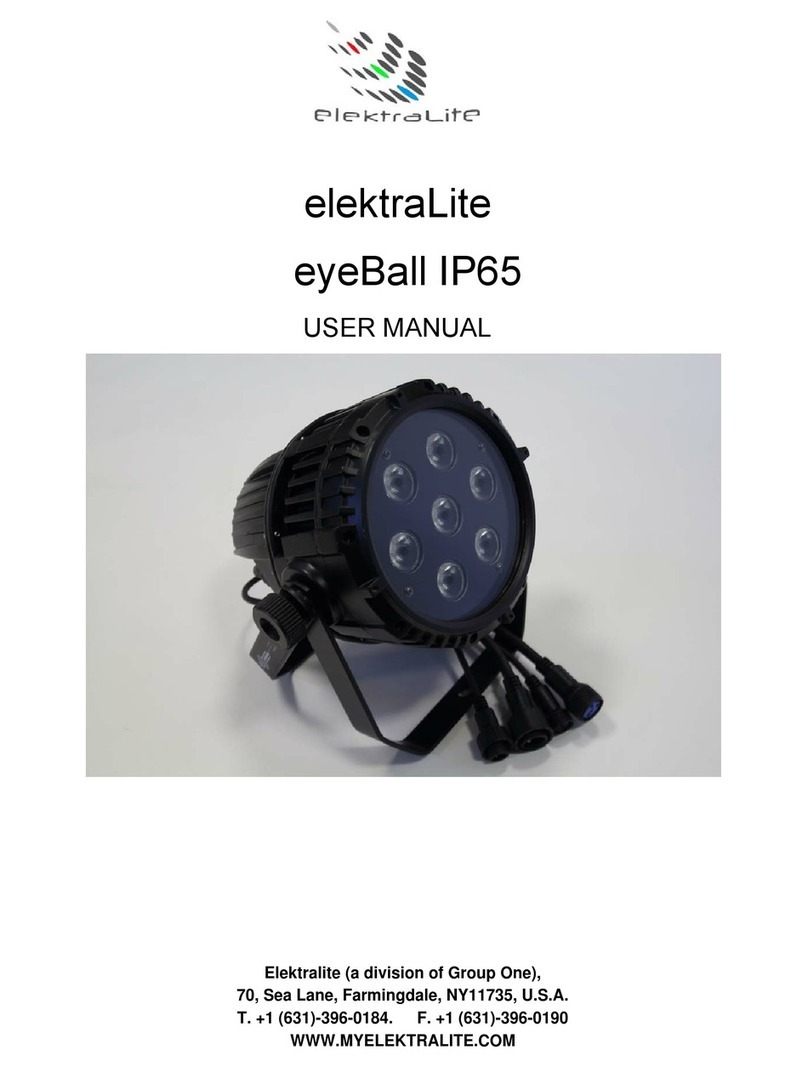
elektraLite
elektraLite eyeBall IP65 User manual
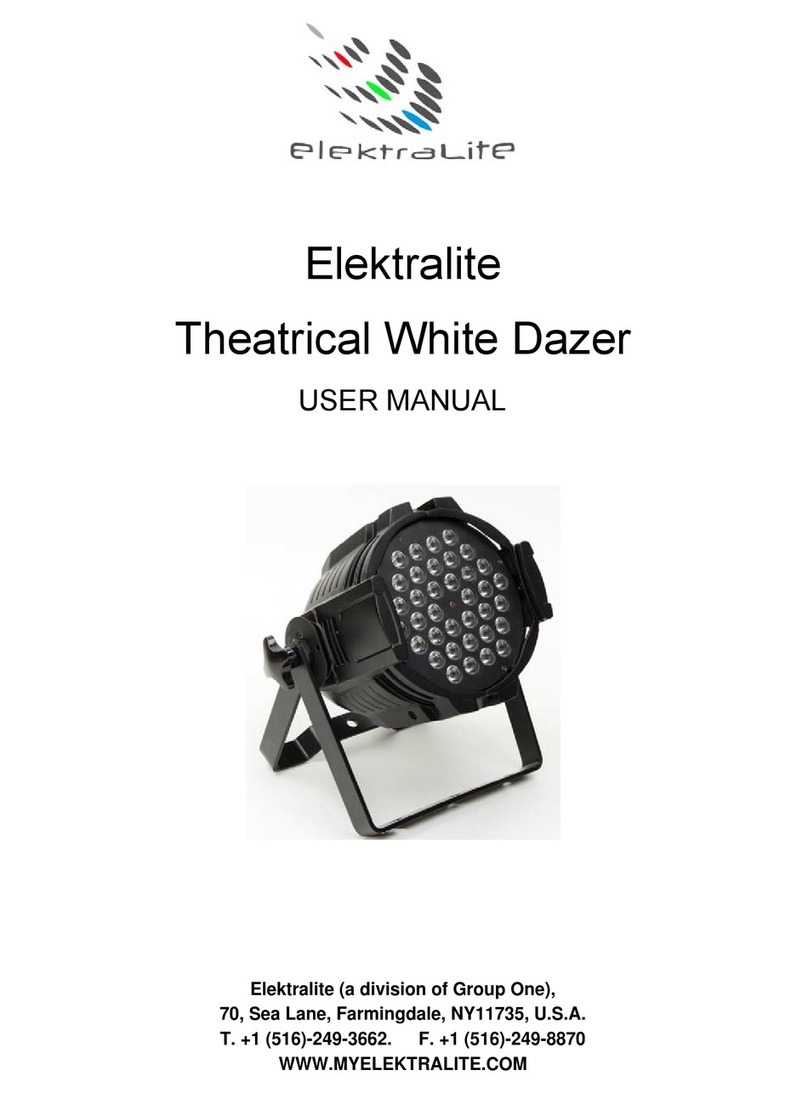
elektraLite
elektraLite Theatrical White Dazer User manual

elektraLite
elektraLite MY575w User manual
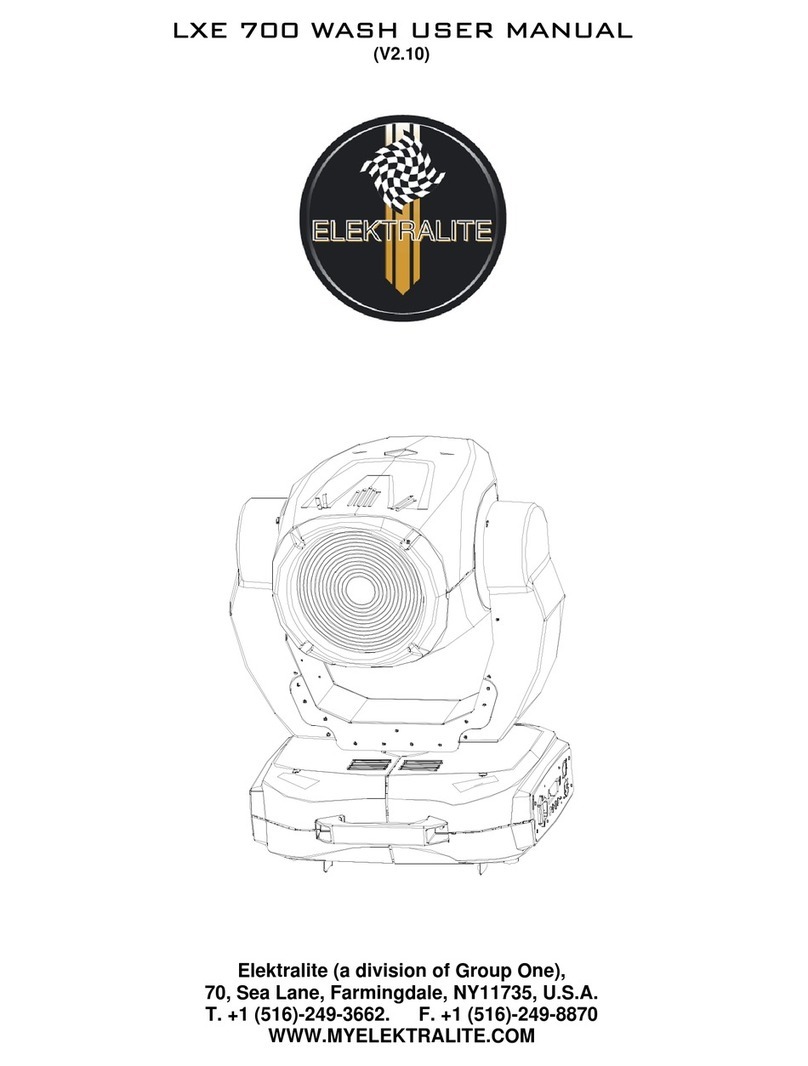
elektraLite
elektraLite LXE 700 Wash User manual

elektraLite
elektraLite MY 575.3 User manual

elektraLite
elektraLite RGBA Dazer User manual
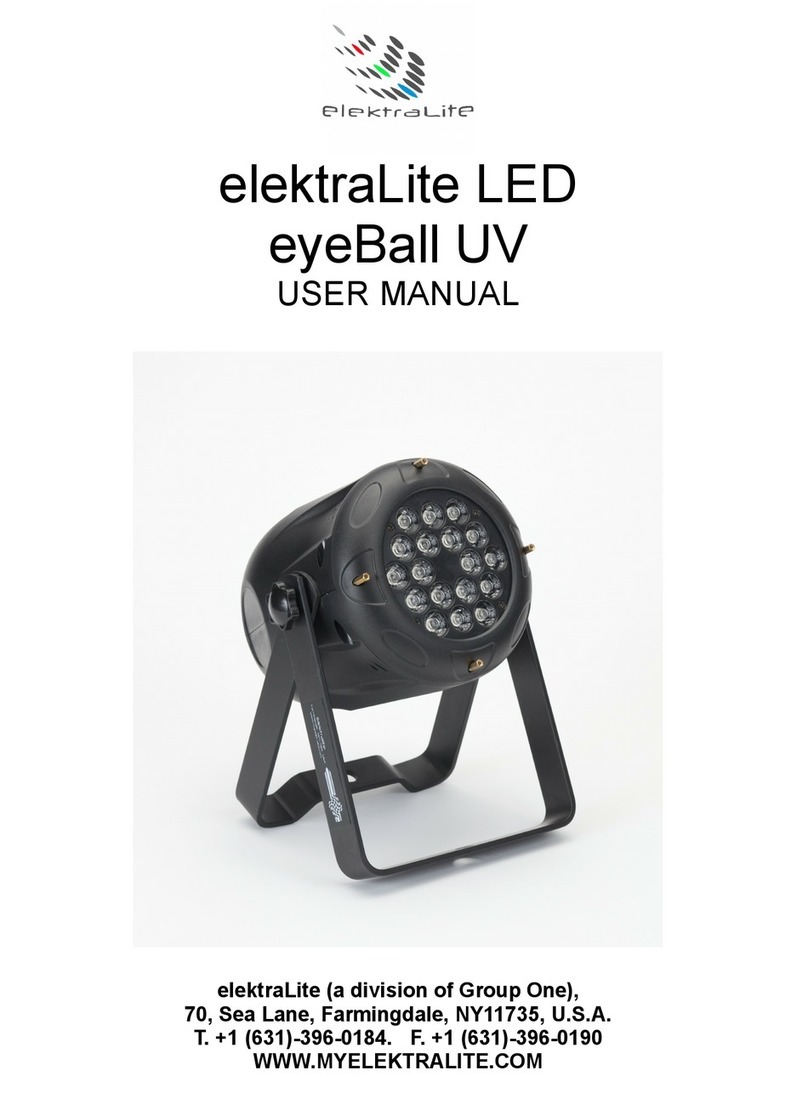
elektraLite
elektraLite eyeBall UV User manual
Popular Lighting Equipment manuals by other brands
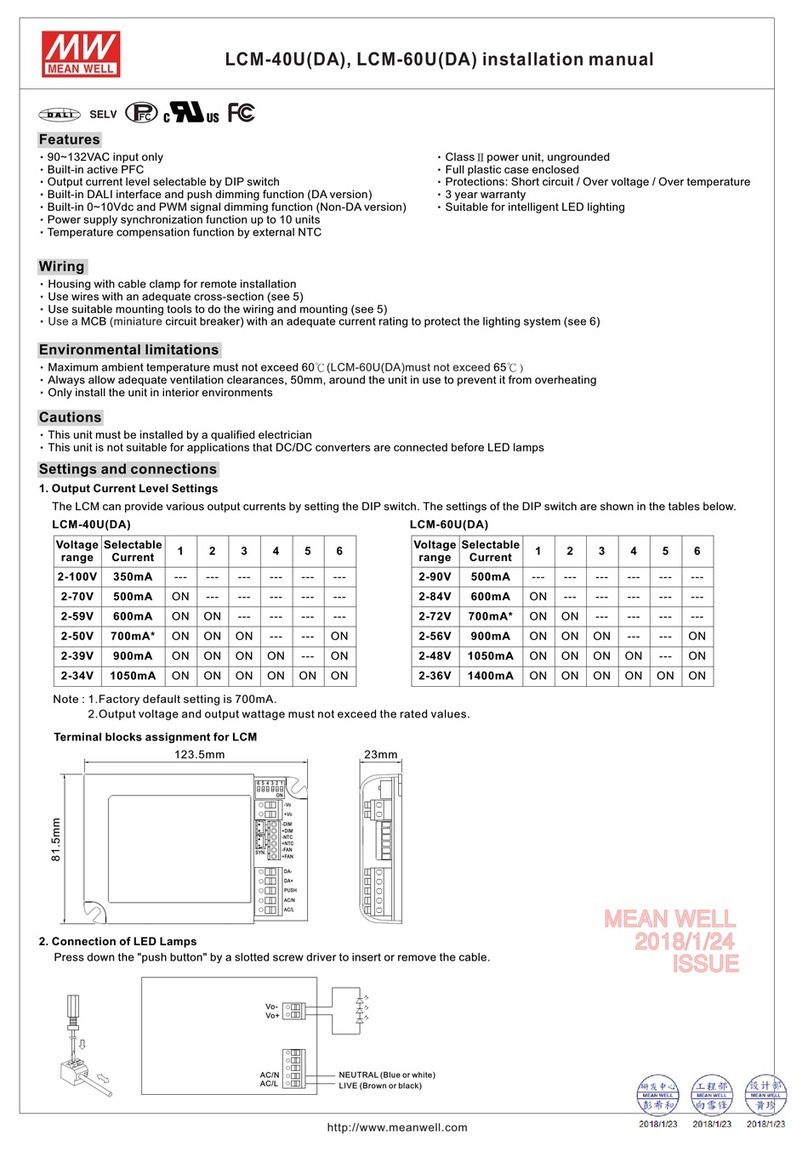
Meanwell
Meanwell LCM-40U installation manual

Lightmybricks
Lightmybricks 42156 installation guide
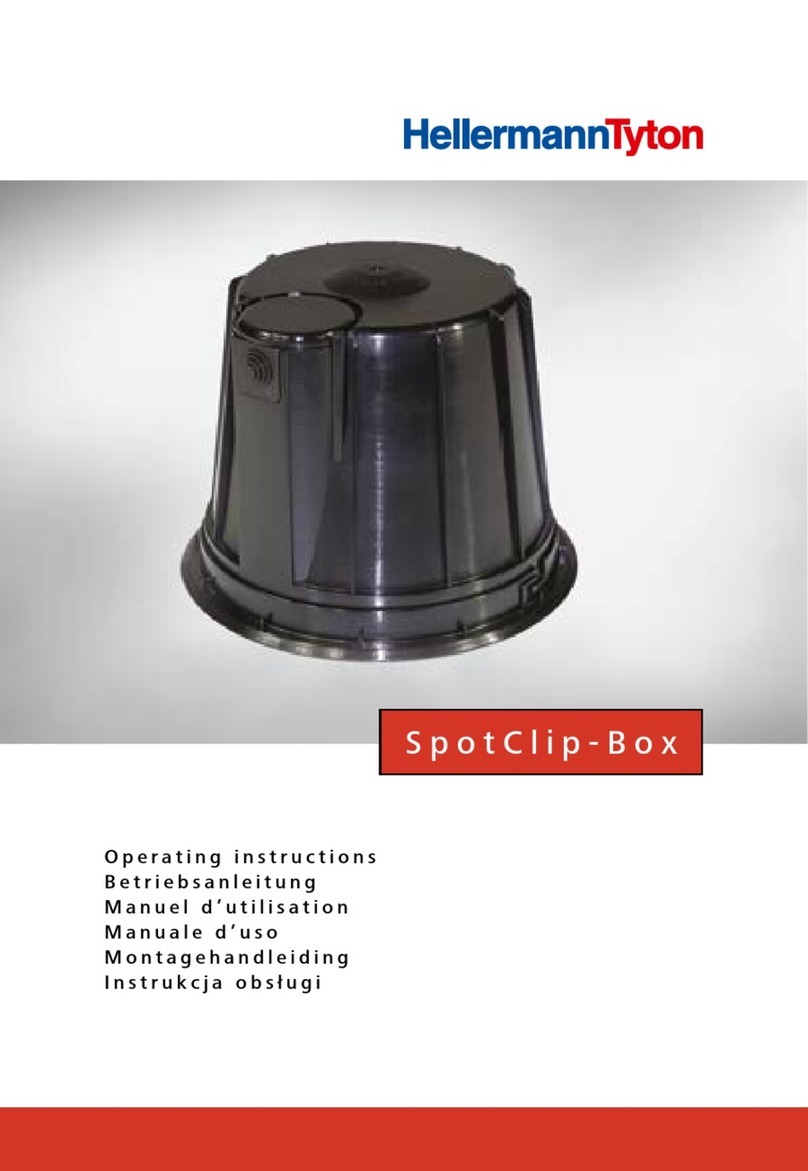
Hellermann Tyton
Hellermann Tyton SpotClip-Box operating instructions
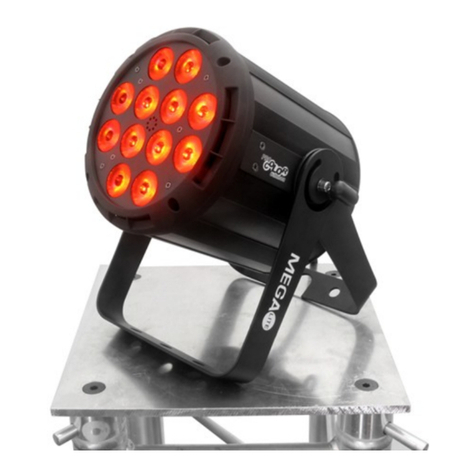
MegaLite
MegaLite Pro Color Cannon 3000 user manual
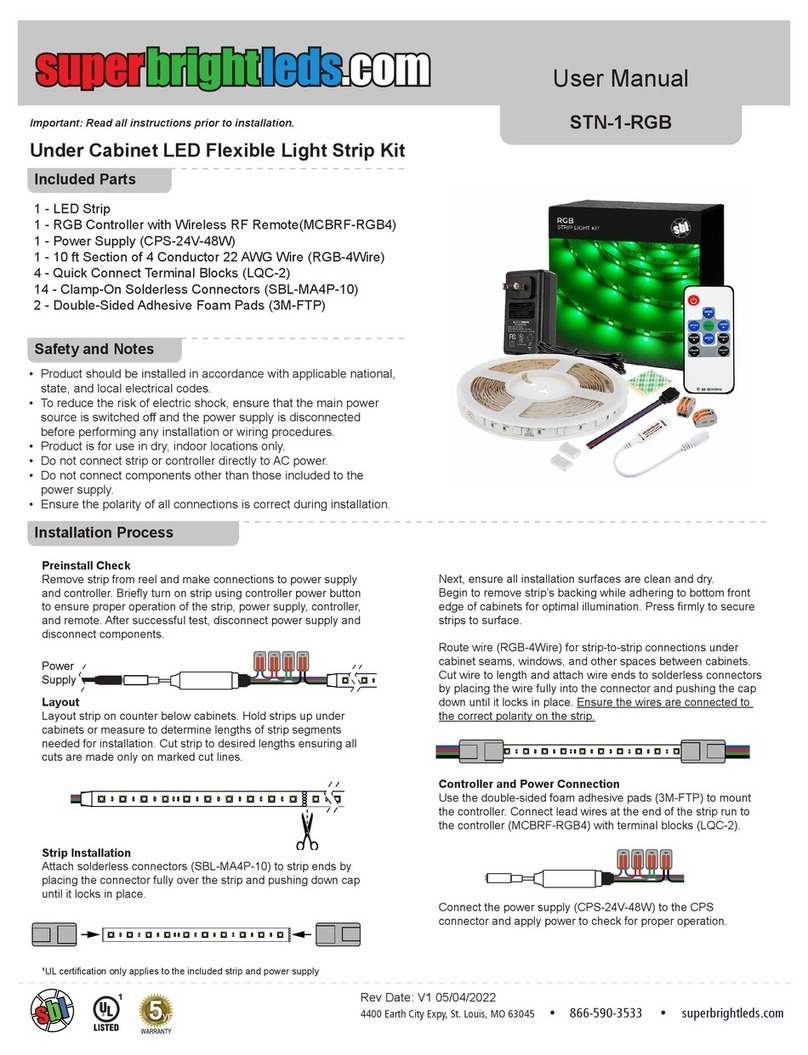
superbrightleds
superbrightleds STN-1-RGB user manual
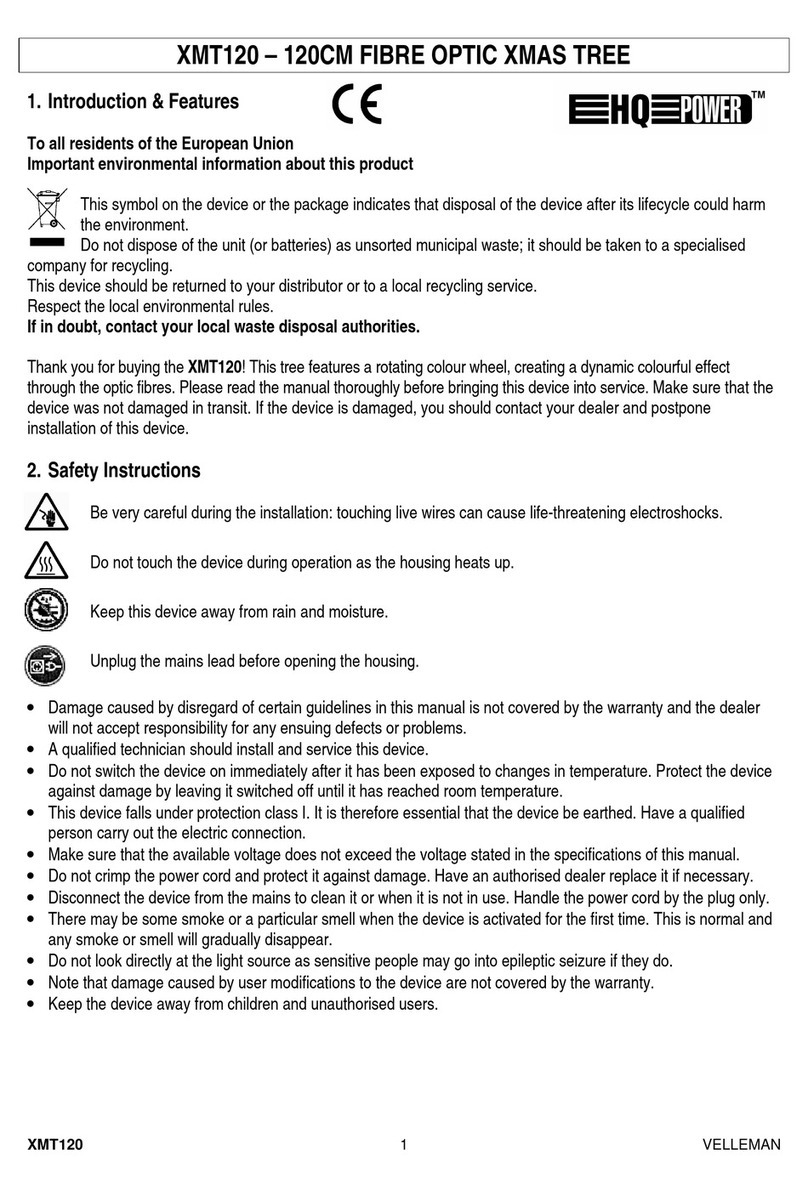
HQ Power
HQ Power XMT120 quick start guide

